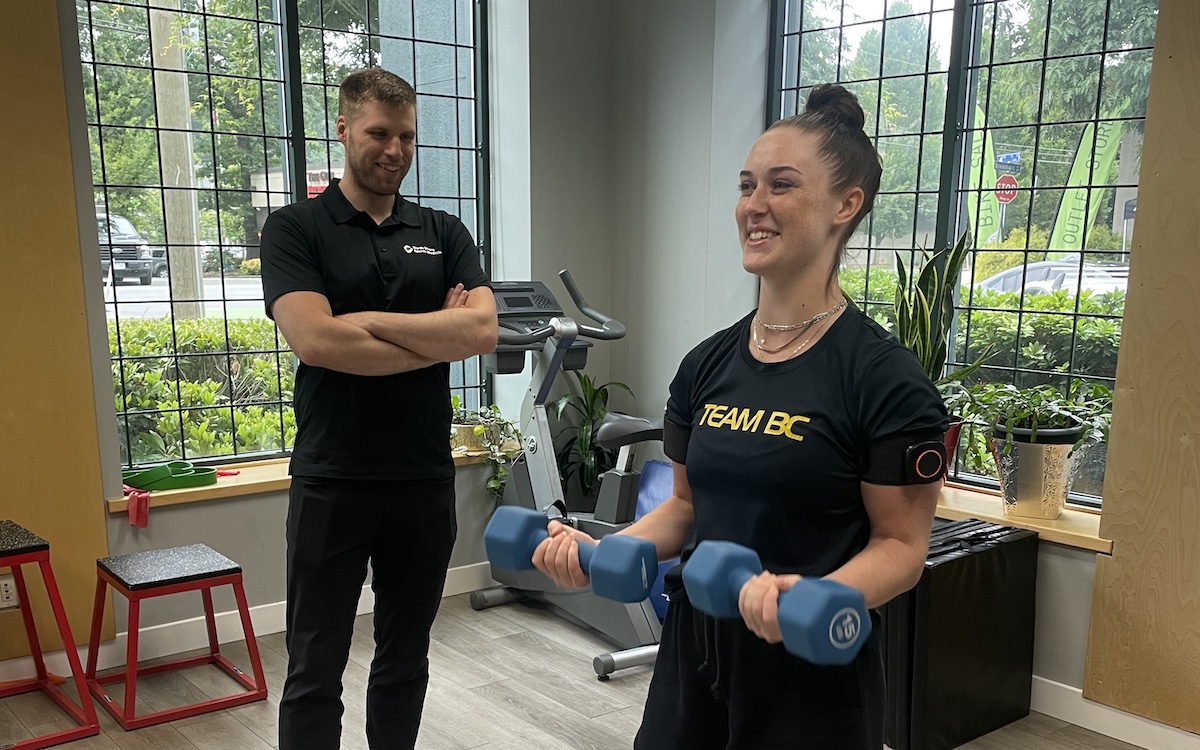What is blood flow restriction training? How does this tool work? These questions and more are answered in today’s blog post.
Blood Flow Restriction (BFR) training dates back to the 1960s in Japan where it was called Kaatsu meaning “additional pressure”. Since the 1960s BFR has undergone many studies in order to ensure that it is effective and safe to use in a rehabilitation and normal exercise settings.
How does it work?
In order to perform Blood Flow Restriction (BFR) training, an external tourniquet is placed around the upper or lower limb in order to create a decrease in the venous return of blood to the heart, which in turn creates a pooling of blood in the limb. The main mechanisms behind the BFR training are a decrease in energy molecules, an inhibition of metabolic by-product removal, and a negative change in the oxygen level of the muscle cells. This essentially forces the muscles to work harder due to the poor environment around them. To think of it in basic terms, BFR training puts the muscles under a similar stress as the last mile of a race, without having to run the first 25 miles. This is especially effective for a rehabilitation setting as patients need to increase strength and tissue tolerance, but loading the tissues too quickly or with too much weight can cause pain or even re-injury. Some of the benefits of BFR training are as follows:
1. Improved Rehabilitation: For those who are injured or have had surgery, BFR can help maintain muscle mass and strength even when heavy resistance training is not possible. Studies have shown that low load (30% of a maximal effort) with BFR training have similar strength and size benefits as lifting at a higher load (70% of a maximal effort) without BFR.
2. Reduced load on joints: Because BFR allows for strength gains with low-intensity exercise, it’s beneficial for individuals who need to limit stress on their joints, such as those recovering from sprains or post-cast stiffness.
3. Improved recovery: BFR has been shown to have an increase in serum testosterone, human growth hormone, and insulin growth factor-1 (IGF-1) post application. An increase in these levels may have a beneficial healing response for injured tissues.
4. Improved muscle strength and size: BFR can stimulate muscle protein synthesis and encourage the body to use fast-twitch muscle fibers, leading to increases in muscle size and strength.
Is it safe?
Yes! It may sound scary to occlude your blood but BFR training has been shown to be safe as long as precautions are taken. Prior to your first time using the BFR cuffs our physiotherapists will ask you to complete a comprehensive screening questionnaire to ensure you don’t have any conditions which may make BFR training unsafe. Some conditions that are screened for include blood issues like venous thromboembolisms, active cancers, pregnancy or gross varicose veins with phlebitis. When the screening is complete and the cuffs are used, some rare side effects like general malaise, fatigue, bruising or transient numbness may occur. If you experience any of these symptoms while using the BFR cuffs just let your physiotherapist know and the pressure can be adjusted or stopped at any time.
Want to see if blood flow restriction training works for you? Book in with our physiotherapist Rob Ogloff to get started!
References
Hughes, L., Paton, B., Rosenblatt, B., Gissane, C., & Patterson, S. D. (2017). Blood flow restriction training in clinical musculoskeletal rehabilitation: A systematic review and meta-analysis. British Journal of Sports Medicine, 51(13), 1003-1011. https://doi.org/10.1136/bjsports-2016-097071
Lorenz, D., Bailey, L., Wilk, K., Mangine, B., Head, P., Grindstaff, T. L., & Morrison, S. (2021). Current clinical concepts: Blood flow restriction training. Journal of Athletic Training, https://doi.org/10.4085/418-20
Minniti, M. C., Statkevich, A. P., Kelly, R. L., Rigsby, V. P., Exline, M. M., Rhon, D. I., & Clewley, D. (2020). The Safety of Blood Flow Restriction Training as a Therapeutic Intervention for Patients With Musculoskeletal Disorders: A Systematic Review. The American journal of sports medicine, 48(7), 1773–1785. https://doi.org/10.1177/0363546519882652
Sato, Y. (2005). The history and future of KAATSU training. International Journal of KAATSU Training Research, 1(1), 1-5. https://doi.org/10.3806/ijktr.1.1
Vanwye, W. R., Weatherholt, A. M., & Mikesky, A. E. (2017). Blood Flow Restriction Training: Implementation into Clinical Practice. International journal of exercise science, 10(5), 649–654.







